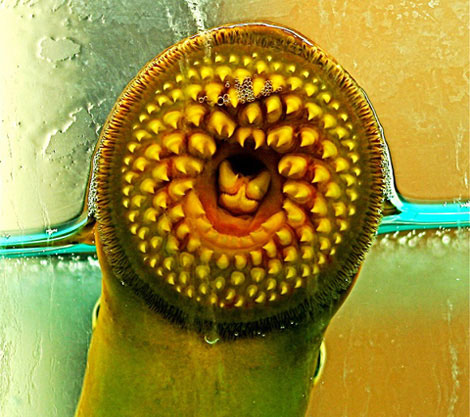Bloodthirsty fish species and
Biologists at the University of Michigan have discovered a range of fat cells near the anterior dorsal fin of male male cobia when the female approaches.
>>>USA attempts to kill horror "vampire" fish
Yu-Wen Chung-Davidson, a biologist at the University of Michigan (USA), co-authored the study, said: "When the bear wakes up from hibernation, brown fat (dark fat tissue in some "Mammals, especially hibernation and young children, help them work again. This fish also has this fat cell to generate heat. This is beyond my imagination."
This is the first time such thermal tissue is found in a cold-blooded species by producing heat that requires more energy and burning more calories, especially cold-blooded animals. But seabass will die once they lay eggs. So it is best to use up all the energy they have to ensure mating.

Sardines, assassins often kill other fish to eat meat.(Photo: Internet)
It is still unclear the true role of temperature during the mating of the grouper. The temperature rises to about 0.3 degrees Celsius and varies depending on the female. That is, males choose more attractive partners to invest more energy.
Water does not transfer heat well, so scientists think that, first, males use hormones or chemical signals to attract females from afar. Then continue to encourage heat reproduction when they come into contact with each other.
When two fish touch the male, the male uses his mouth to attach to the head of the female, and they start pushing eggs and sperm into the water. The gametes nest in the depression of the stone, the gravel that the female digs with its tail.
Seabass grouper is considered a parasite. They feed on the blood of other fish in both freshwater and saltwater and become an invasive species in the Great Lakes region. The team hopes that an understanding of how they mate will help them develop plans to control fish populations more effectively.
Mr. Chung-Davidson said: "Throughout life, rocky grouper kills about 18kg of fish. It is a big problem in the Great Lakes region in North America."
The research has just been published in Experimental Biology last week.
- 10 prehistoric monsters cause horrors at sea
- 10 most expensive fishes in the world
- The risk of extinction of four precious fish species in the Red River
- Some fish species live in the harshest place on earth
- A close-up of the 'extremely toxic' fishes off New Zealand
- Meet the only fish species in the world that can
- Detecting exotic rare fish in Nam Dinh
- The most beautiful aquarium fish
- Protecting rare and precious fish species in flipping Binh Thien
- Listed 10 fish species that have a talent for terrestrial hunting in the natural world
- Close-up of the species
- Fish also suffer from arthritis like humans?
 Surprised: Fish that live in the dark ocean still see colors
Surprised: Fish that live in the dark ocean still see colors Japan suddenly caught the creature that caused the earthquake in the legend
Japan suddenly caught the creature that caused the earthquake in the legend A series of gray whale carcasses washed ashore on California's coast
A series of gray whale carcasses washed ashore on California's coast Compare the size of shark species in the world
Compare the size of shark species in the world